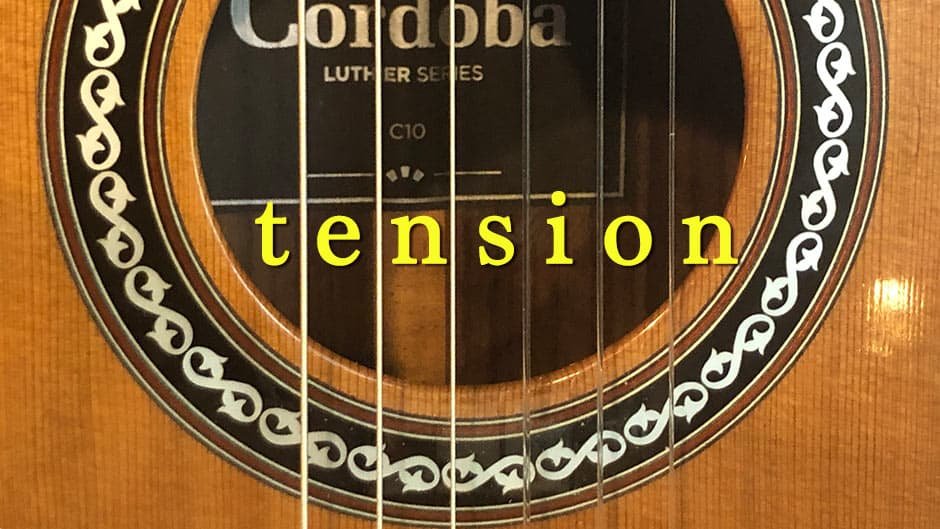While learning the classical guitar, a player will at some point come across the term ‘high tension strings’ and start to wonder. What are they really? Why would anyone want to use them? Am I missing a trick in not trying them out?
A beginner’s guitar will have ‘normal’ tension strings, also known as medium tension strings. (Although there are notable exceptions – some Cordoba and Alhambra models come factory-fitted with high tension strings even at the lower price end.) So why do some players switch to high tension strings?
Players who use high tension strings do so for an increase in volume, a brighter sound, lush vibratos and an overall complex upper-partials-rich tone that sits well with a more modern repertoire.
The trade-off is that high tension strings, as we’ll see shortly, require more physical effort from the left hand to keep them pressed to the fingerboard. This can be strenuous and tiring over long sessions of practice, especially for beginners just getting used to the instrument.
Table of Contents
What is the difference between high tension and normal tension classical guitar strings?
Classical guitar strings are grouped by tension values: light, medium and hard tension. Also known as low, normal and high tension strings.
Folks in the acoustic/electric world talk about string gauges to indicate string tension. Gauge is the diameter of a string. A thicker string is considered ‘high tension’ for the simple reason that it takes more tension to make something thick vibrate at the correct pitch. A thinner string for a similar reason is low tension. This is true in the classical guitar world too – to an extent, as we’ll see soon. By the way, classical guitar strings are of much lower tension than steel strings overall.

Look at the following table that compares a popular classical string brand D’Addario’s normal tension E string (sixth string) with its own high tension E string.
| Type | Note | Diameter (in) | Tension (lbs) | |
| D’Addario EJ45 | Normal Tension | E | 0.028” 0.711 mm | 16.23 |
| D’Addario EJ46 | Hard Tension | E | 0.0285” 0.724 mm | 16.81 |
It’s easy to see from the table that the hard tension (high tension) string is thicker and needs more tension (force) to bring it to pitch than the normal tension string. Yet this simple relationship between thickness (gauge) and tension does not always hold true with all classical guitar string brands.
Look at the following table for another popular brand Savarez’s normal tension E string (sixth string) compared to its own high tension E string.
| Type | Note | Diameter (in) | Tension (lbs) | |
| Savarez 510CR | Normal Tension | E | 0 .0287” 0.729 mm | 15.89 |
| Savarez 520J | High Tension | E | 0 .0287” 0.729 mm | 18.66 |
The diameter is exactly the same in either case. Yet one of them is high tension and the other is not. It follows that high tension strings are generally heavy strings, while normal and low tension are lighter strings. This extra ‘heaviness’ or mass may be due to the increased thickness or the nature of the nylon compounds used.
The three treble strings are commonly made of nylon compounds. A wide array of compounds (typically nylon wrapped in some form of metal) is used to create the three heavier bass strings. In effect, all six strings can be manufactured in whatever tension type required, high, normal or low.
In addition, strings can also be made of more dense fluorocarbons, known as carbon strings. And these too have their tension variants. Choices, choices… (To know more about why you might want to consider carbon strings for your guitar, read my article Try Carbon.)
High tension strings for a different tone, a different ‘touch’
High tension classical guitar strings are louder and have a tighter vibration. They generate more upper partials (higher frequencies) for a complex sound that players with a modern repertoire prefer.
Many players believe high tension strings are perfect for music in the traditional Spanish or Latin mold. For fast runs and modern pieces as well as flamenco music, the extroverted sounds from high tension strings are a good match. Normal tension strings, by contrast, vibrate loosely and produce a clearer fundamental note that players of a more conventional repertoire will prefer. Think Sor or Bach.
Crossover players generally prefer high tension strings for the increased volume. High tension strings are also forgiving of a more aggressive touch. They will not buzz.
Although we talk of ‘high tension strings’ as though they were a uniform lot, there is actually no agreed upon standard among manufacturers. Broadly speaking, European makes like Savarez and Hannabach lean towards greater tension than their US counterparts like D’Addario and La Bella.
The simple act of playing different tensions of string brings to light differences in touch or playability as well. High tension strings feel “tighter” to play when fully tuned. They feel more rigid to the touch than medium tension strings.
High tension strings are physically harder to press down against the fretboard than normal tension strings. So if you have weak hands or if you are a beginner, normal tension strings will work well for you. If you are a ‘heavy-handed’ player, as some of us are, normal tension strings will start buzzing. Such players naturally take to high tension strings happily.
So what tension should your classical guitar strings be?
For beginners and early intermediates, it makes sense to stick to normal tension strings because these players may not have developed sufficient strength or technique in the left hand to persistently use high tension strings on a daily basis. As noted earlier, high tension strings require more effort to press down and can be tiring at the end of a long practice session.
For more advanced players, high tension strings bring into play a refreshing and different tonal color and greater volume. This is worth experimenting with and even celebrating! There are various brand choices out there to help you create and cement your own creative voice.
My own recommendation is to start your experimentation with variants of the same brand. For instance, D’Addario Pro Arte a leading brand that offers numerous tensions can be a great start. Choose a tension type and get to know the sound over a few weeks. Then skip a step and go from, let’s say, light to hard (skipping medium). Or go from medium to extra hard (skipping hard). You will hear the differences better because the tensions are significantly different.
An additional thing you can do to hear the differences clearly is to change only one string, say, the first string. You can listen to it in the context of the other, older strings.
Some voices from the www (paraphrased):
I usually prefer normal tension strings… they sound romantic… and high tension strings have a modern character.
I like normal tension strings, they are easier on my hands. Once in a while I will put on Augustine Blue Regals HT for a change.
If there are a lot of harmonics in a song, they come out well on high tension strings. Love the La Bella 2001 HT for that.
My strings of choice is D’Addario EJ45. Standard and normal… but they last a long time and very consistent.
Normal tension vs high tension strings: Your guitar can guide you
Often, a guitar manufacturer will take the matter out of your hands. They will recommend that you use high tension strings on their guitar model or they may advise you never to use high tension strings on it.
With one of my guitars, an Amalio Burguet Concert 1A, the manufacturer (whom I met with face to face in Valencia) informed me repeatedly to NOT use high tension strings on it. Only normal tension please, was the instruction set in stone.
This sort of manufacturer specification on whether or not to use high tension strings on their guitar models has mostly to do with bracing. While bracing is a large subject in its own right, for our purposes, we can say this much: If your guitar top is lightly braced like with many handmade guitars, normal tension strings will be your best option.
They will give you the best sound and volume because it takes less energy to get the top moving. High tension strings will pull at the top too hard and in extreme cases may even rip the bridge off eventually.
On the other hand, if your guitar top is braced heavily, normal tension strings may not have enough energy to move the top. You will need high tension strings to literally get things moving.
By and large, factory-built guitars today are over braced for durability. So high tension strings will likely sound better and deliver more volume on such guitars. The point to note here is that because of such variables as bracing and manufacturer recommendations, you may end up with normal tension or high tension strings by default.
When you do have a free choice, you may choose to go with high tension strings, depending upon how your guitar reacts to the strings. And what you consider is an improvement in sound.
That may be the most important point of all. In the end, the choice of which tension strings to use will depend on what pleases you. And your knowledge of what pleases you will increase with experimentation. Here are a few popular high tension strings (with Amazon links) for you to check out:
- D’Addario EJ46 – Popular, affordable, consistent quality, long lasting hard tension strings
- La Bella 2001 Concert Series – Highly rated, reputed name for hard tension strings
- Savarez 520J – Traditional series of high tension strings with rectified nylon trebles
- Augustine Regal/Blue HT – Tried and tested high tension strings from the pioneer of nylon strings for classical guitar
- Hannabach Series 815 HT – German, expensive, iconic high tension set
For a fuller discussion on classical guitar strings with lots more string options to consider, see my article 5 Step Guide to Choosing Your Perfect Strings. About your bass strings specifically, I have an article Bronze or Silver Basses? to help you decide what will work perfectly for you. To find out what today’s professional players recommend by way of tips, see our interview with concert guitarist Colin Davin.
_____________
Happy tensions!


HI narayan, I happily bought a 7p Alhambra! Trying the strings 540j Savarez HT, I realized that especially the 4 and 5 string buzz by pressing on the first frets. Is this normal or is it due to the fact that they are new? Or does it depend on other factors? (action, frets, etc…)
Doesn’t seem to be normal from my experience. HT strings sit so well (generally) on the 7P. Perhaps it’s to do with some of the other factors you mention – action, fret height, etc.
Will going from high to low require a new setup? Will it change the neck relief?
Not that I know of in any perceptible manner in my experience. But it may have something to do with the brand of guitar and its age, perhaps. I’m guessing, I have no direct experience of this including those of folks I know well.